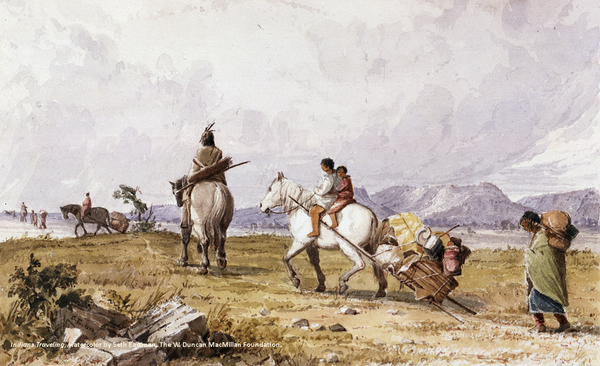Dublin Core
Title
Description
Migration and travel have shaped Utah. And Utah has shaped the way we migrate and travel. Literally. Over time, travel routes through Utah have tended to stay the same.
Utah’s ruggedly beautiful landscape draws admiration and visitors, but has always posed major obstacles to travel. In the distant past Native peoples pioneered the most forgiving paths through the jumbled landforms and arid deserts, and these trails largely defined the journeys made by later travelers. When trappers and explorers like Jedediah Smith and John Frémont “blazed” trails, they were actually following paths that had been trod by Native feet for centuries. Indeed, it was often Native peoples who showed intrepid explorers and pioneers the way.
Following these same paths, the “Old Spanish Trail” shows the difficulties posed by Utah’s landscape and the literal lengths that some would go to overcome them. In the 1830s and 1840s, unforgiving terrain and chronic conflicts with Native peoples discouraged direct travel between the Mexican cities of Santa Fe and Los Angeles. Instead, caravans of horses and mules made a circuitous trek through modern-day Utah, crossing the Colorado and Green Rivers, arcing north of the San Rafael Swell, then south again to the Mojave Desert.
During the same era, heavy traffic along the Overland Trail system caused a search for fresh pastures and alternate routes, stimulating trail variations known as “cutoffs.” In Utah, none was more important than the 1845 Hastings Cutoff, which brought California-bound travelers through the challenging Wasatch Mountains to the west desert salt flats. This route became well-trodden thanks to the tide of Mormon migration that began in 1847.
Journeys along the Overland Trail system declined after the transcontinental railroad was completed in Utah in 1869. Permanent railroad lines tended to follow the paths of least resistance already carved by trails and wagon roads. In many places, railroads were merely new technology layered over well-established routes.
The same holds true for Utah’s roads. In the early twentieth century, gravel highways replicated well-established patterns of movement, and our modern interstates generally follow those same historical routes – overland trails and the original transcontinental railroad.
Creator
Gregory Smoak of The American West Center, University of Utah © 2014
Source
Image: Indians Traveling, watercolor by Seth Eastman, The W. Duncan MacMillan Foundation.
______________
See Will Bagley, So Rugged and Mountainous: Blazing the Trails to Oregon and California, 1812-1848 (University of Oklahoma Press, 2010). Forrest Cuch, ed., A History of Utah’s American Indians (Utah Division of Indian Affairs, 1996). Jared Farmer, On Zion’s Mount: Mormons, Indians, and the American Landscape (Harvard University Press, 2010). LeRoy R. Hafen and Ann W. Hafen, Old Spanish Trail: Santa Fe to Los Angeles (University of Nebraska Press, 1993). Michael W. Holmer, ed., On the Way to Somewhere Else: European Sojourners in the Mormon West (University of Utah Press, 2010). Wallace Stegner, The Gathering of Zion: The Story of the Mormon Trail (University of Nebraska Press, 1992). Richard White, Railroaded: The Transcontinentals and the Making of Modern America (W.W. Norton, 2010).
Publisher
The Beehive Archive is a production of Utah Humanities. Find sources and the whole collection of past episodes at www.utahhumanities.org
Date
2014-05-23

